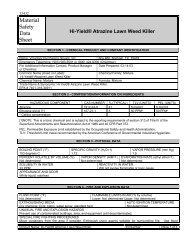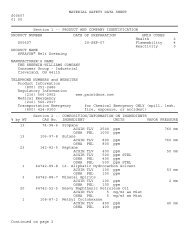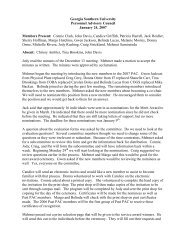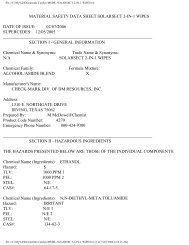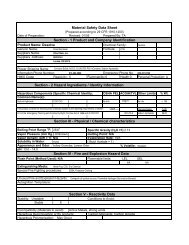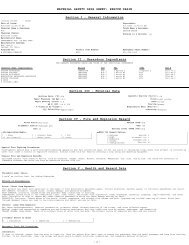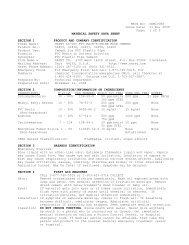Pyridine, anhydrous, 99.0%,< 50 ppm water - services
Pyridine, anhydrous, 99.0%,< 50 ppm water - services
Pyridine, anhydrous, 99.0%,< 50 ppm water - services
You also want an ePaper? Increase the reach of your titles
YUMPU automatically turns print PDFs into web optimized ePapers that Google loves.
effects similar to those for inhalation exposure. Effects may be delayed.Inhalation: Inhalation of high concentrations may cause central nervous system effectscharacterized by nausea, headache, dizziness, unconsciousness and coma. May cause respiratorytract irritation. Prolonged exposure may result in dizziness and general weakness. Othersymptoms reported with acute exposure to pyridine include nervousness, insomnia, and loss ofappetite.Chronic: Prolonged or repeated skin contact may cause dermatitis. Chronic inhalation andingestion may cause effects similar to those of acute inhalation and ingestion. May cause liverand kidney damage. Exposures to doses of pyridine that are too low to produce overt clinicalsymptoms can cause liver damage and repeated low-level exposures can cause cirrhosis. Feedingstudies in rats produced blood effects like changes in clotting factors.Section 4 - First Aid MeasuresEyes: In case of contact, immediately flush eyes with plenty of <strong>water</strong> for at least 15 minutes.Get medical aid immediately.Skin: In case of contact, immediately flush skin with plenty of <strong>water</strong>. Remove contaminatedclothing and shoes. Get medical aid. Wash clothing before reuse.Ingestion: If swallowed, do not induce vomiting unless directed to do so by medical personnel.Never give anything by mouth to an unconscious person. Get medical aid.Inhalation: If inhaled, remove to fresh air. If not breathing, give artificial respiration. Ifbreathing is difficult, give oxygen. Get medical aid.Notes to Physician: Treat symptomatically and supportively.Section 5 - Fire Fighting MeasuresGeneral Information: As in any fire, wear a self-contained breathing apparatus inpressure-demand, MSHA/NIOSH (approved or equivalent), and full protective gear. Vapors mayform an explosive mixture with air. Vapors can travel to a source of ignition and flash back.During a fire, irritating and highly toxic gases may be generated by thermal decomposition orcombustion. Water may be ineffective. Material is lighter than <strong>water</strong> and a fire may be spread bythe use of <strong>water</strong>. Containers may explode in the heat of a fire. Flammable liquid and vapor.Vapors may be heavier than air. They can spread along the ground and collect in low or confinedareas.Extinguishing Media: For small fires, use dry chemical, carbon dioxide, <strong>water</strong> spray oralcohol-resistant foam. For large fires, use <strong>water</strong> spray, fog, or alcohol-resistant foam. Do NOTuse straight streams of <strong>water</strong>. Cool containers with flooding quantities of <strong>water</strong> until well afterfire is out. Solid streams of <strong>water</strong> may be ineffective and spread material.Section 6 - Accidental Release MeasuresGeneral Information: Use proper personal protective equipment as indicated in Section 8.Spills/Leaks: Absorb spill with inert material (e.g. vermiculite, sand or earth), then place insuitable container. Avoid runoff into storm sewers and ditches which lead to <strong>water</strong>ways. Clean upspills immediately, observing precautions in the Protective Equipment section. Remove allsources of ignition. Use a spark-proof tool. Provide ventilation. A vapor suppressing foam may beused to reduce vapors. Prevent spreading of vapors through sewers, ventilation systems andhttps://fscimage.fishersci.com/msds/91562.htm (2 of 7) [2/15/2002 1:51:45 AM]
confined areas. Evacuate unnecessary personnel. Approach spill from upwind. U.S. regulationsrequire reporting spills and releases to soil, <strong>water</strong> and air in excess of reportable quantities.Section 7 - Handling and StorageHandling: Wash thoroughly after handling. Remove contaminated clothing and wash beforereuse. Ground and bond containers when transferring material. Do not get in eyes, on skin, or onclothing. Empty containers retain product residue, (liquid and/or vapor), and can be dangerous.Keep container tightly closed. Avoid contact with heat, sparks and flame. Do not pressurize, cut,weld, braze, solder, drill, grind, or expose empty containers to heat, sparks or open flames. Donot breathe vapor. Use only with adequate ventilation.Storage: Keep away from heat, sparks, and flame. Keep away from sources of ignition. Store ina tightly closed container. Store in a cool, dry, well-ventilated area away from incompatiblesubstances. Flammables-area. Store under argon. Isolate from oxidizing materials and acids.Section 8 - Exposure Controls, Personal ProtectionEngineering Controls: Use process enclosure, local exhaust ventilation, or other engineeringcontrols to control airborne levels below recommended exposure limits. Facilities storing orutilizing this material should be equipped with an eyewash facility and a safety shower.Ventilation fans and other electrical service must be non-sparking and have an explosion-proofdesign.Exposure LimitsChemical Name ACGIH NIOSH OSHA - Final PELs5 <strong>ppm</strong> TWA; 15 mg/m3 5 <strong>ppm</strong> TWA; 15 mg/m3<strong>Pyridine</strong> 5 <strong>ppm</strong> TWATWA 1000 <strong>ppm</strong> IDLH TWAOSHA Vacated PELs: <strong>Pyridine</strong>: 5 <strong>ppm</strong> TWA; 15 mg/m3 TWAPersonal Protective EquipmentEyes: Wear chemical goggles and face shield.Skin: Wear appropriate protective gloves to prevent skin exposure.Clothing: Wear appropriate protective clothing to prevent skin exposure.Respirators: Follow the OSHA respirator regulations found in 29CFR 1910.134 or EuropeanStandard EN 149. Always use a NIOSH or European Standard EN 149 approved respirator whennecessary.Section 9 - Physical and Chemical PropertiesPhysical State: LiquidAppearance: colorless to light yellowOdor: strong odor - fish-likepH: 8.5 (0.2 M aq soln)Vapor Pressure: 18 mm Hg @ 20 deg CVapor Density: 2.73 (Air=1)Evaporation Rate:Not available.https://fscimage.fishersci.com/msds/91562.htm (3 of 7) [2/15/2002 1:51:45 AM]
Viscosity: 0.95 mPa s 20 deg CBoiling Point: 115 deg CFreezing/Melting Point:-42 deg CAutoignition Temperature: 900 deg F ( 482.22 deg C)Flash Point: 17 deg C ( 62.60 deg F)Decomposition Temperature:Not available.NFPA Rating: (estimated) Health: 3; Flammability: 3; Reactivity: 0Explosion Limits, Lower: 1.8%Upper: 12.4%Solubility: Miscible in <strong>water</strong>. Volatile in steam.Specific Gravity/Density:.9700Molecular Formula:C5H5NMolecular Weight:79.10Section 10 - Stability and ReactivityChemical Stability: Stable under normal temperatures and pressures.Conditions to Avoid: Ignition sources, excess heat, electrical sparks, exposure to flame.Incompatibilities with Other Materials: Acids; acid chlorides; oxidizing agents;chloroformates; bromine trifluoride; mixtures with formamide, iodine, and sulfur trioxide,chlorosulfonic acid, chromic acid, maleic anhydride, sulfuric acid, perchromates, and dinitrogentetroxideHazardous Decomposition Products: Nitrogen oxides, carbon monoxide, carbon dioxide,cyanide fumes.Hazardous Polymerization: Will not occur.Section 11 - Toxicological InformationRTECS#:CAS# 110-86-1: UR8400000LD<strong>50</strong>/LC<strong>50</strong>:CAS# 110-86-1:Dermal, guinea pig: LD<strong>50</strong> = 1 gm/kg;Draize test, rabbit, skin: <strong>50</strong>0 mg/24H Mild;Inhalation, rat: LC<strong>50</strong> = 28<strong>50</strong>0 mg/m3/1H;Oral, mouse: LD<strong>50</strong> = 1<strong>50</strong>0 mg/kg;Oral, rat: LD<strong>50</strong> = 891 mg/kg;Skin, rabbit: LD<strong>50</strong> = 1121 mg/kg;Carcinogenicity:CAS# 110-86-1:IARC: Group 3 carcinogenEpidemiology: No information available.Teratogenicity: <strong>Pyridine</strong> caused muscle/skeletal effects when injected into developing chickensbut was not teratogenic in frogs at sublethal doses. The relevance of these studies to humanreproduction is unclear.Reproductive Effects: No information available.Neurotoxicity: No information available.Mutagenicity: <strong>Pyridine</strong>'s mutagenicity potential is equivocal. It was reported to be both positiveand negative in Salmonella typhimurium strains. It was not mutagenic in tests for chromosomehttps://fscimage.fishersci.com/msds/91562.htm (4 of 7) [2/15/2002 1:51:45 AM]
aberrations, but did give weak positive results in tests that detect sister chromatid exchanges.Other Studies: Hazards associated with pyridine may be seen in this produc t. See actual entryin RTECS for complete information.Section 12 - Ecological InformationEcotoxicity: Fish: Fathead Minnow: 106mg/L; 96H; Flow-through No data available.Environmental: Terrestrial: Should have very high mobility. It is adsorbed to acid clay to amoderate extent. Complete degradation in one soil occurred in less than 8 days. Aquatic: Shouldbiodegrade after an acclimation period and can also be lost through volatilization. Atmospheric:Exists in the vapor phase based on a vapor pressure of 20.80 mm Hg and react slowly withphotochemically produced hydroxy radicals with experimental half-lives of 32 and 16 days inclean and moderately polluted atmospheres, respectively. Bioconcentration in aquatic organismsshould not be significant.Physical: No information available.Other: For more information, see "HANDBOOK OF ENVIRONMENTAL FATE AND EXPOSUREDATA."Section 13 - Disposal ConsiderationsChemical waste generators must determine whether a discarded chemical is classified as ahazardous waste. US EPA guidelines for the classification determination are listed in 40 CFR Parts261.3. Additionally, waste generators must consult state and local hazardous waste regulationsto ensure complete and accurate classification.RCRA P-Series: None listed.RCRA U-Series: CAS# 110-86-1: waste number U196.Section 14 - Transport InformationUS DOT IATA RID/ADR IMO Canada TDGShipping Name: PYRIDINENo informationavailable.Hazard Class: 3UN Number: UN1282Packing Group: IISection 15 - Regulatory InformationUS FEDERALTSCACAS# 110-86-1 is listed on the TSCA inventory.Health & Safety Reporting Listhttps://fscimage.fishersci.com/msds/91562.htm (5 of 7) [2/15/2002 1:51:45 AM]
CAS# 110-86-1: Effective Date: October 4, 1982; Sunset Date: October 4 , 1992Chemical Test RulesNone of the chemicals in this product are under a Chemical Test Rule.Section 12bNone of the chemicals are listed under TSCA Section 12b.TSCA Significant New Use RuleNone of the chemicals in this material have a SNUR under TSCA.SARASection 302 (RQ)CAS# 110-86-1: final RQ = 1000 pounds (454 kg)Section 302 (TPQ)None of the chemicals in this product have a TPQ.SARA CodesCAS # 110-86-1: acute, chronic, flammable.Section 313This material contains <strong>Pyridine</strong> (CAS# 110-86-1, 99 0%),which is subject to the reportingrequirements of Section 313 of SARA Title III and 40 CFR Part 373.Clean Air Act:This material does not contain any hazardous air pollutants. This material does not contain anyClass 1 Ozone depletors. This material does not contain any Class 2 Ozone depletors.Clean Water Act:None of the chemicals in this product are listed as Hazardous Substances under the CWA. Noneof the chemicals in this product are listed as Priority Pollutants under the CWA. None of thechemicals in this product are listed as Toxic Pollutants under the CWA.OSHA:None of the chemicals in this product are considered highly hazardous by OSHA.STATECAS# 110-86-1 can be found on the following state right to know lists: California, New Jersey,Florida, Pennsylvania, Minnesota, Massachusetts.California No Significant Risk Level: None of the chemicals in this product are listed.European/International RegulationsEuropean Labeling in Accordance with EC DirectivesHazard Symbols:XN FRisk Phrases:R 11 Highly flammable.R 20/21/22 Harmful by inhalation, in contact withskin and if swallowed.Safety Phrases:S 26 In case of contact with eyes, rinse immediatelywith plenty of <strong>water</strong> and seek medical advice.S 28 After contact with skin, wash immediatelywith...WGK (Water Danger/Protection)CAS# 110-86-1: 2CanadaCAS# 110-86-1 is listed on Canada's DSL List. CAS# 110-86-1 is listed on Canada's DSL List.This product has a WHMIS classification of B2, D2A, D2B.CAS# 110-86-1 is listed on Canada's Ingredient Disclosure List.Exposure LimitsCAS# 110-86-1: OEL-ARAB Republic of Egypt:TWA 5 <strong>ppm</strong> (15 mg/m3) OEL-AUSTRALIA:TWA 5 <strong>ppm</strong> (15 mg/m3) OEL-BELGIUM:TWA 5 <strong>ppm</strong> (16 mg/m3) OEL-CZECHOSLOVAKIA:TWA 5 mg/m3;STEL 10 mg/m3 JAN9 OEL-DENMARK:TWA 5 <strong>ppm</strong> (https://fscimage.fishersci.com/msds/91562.htm (6 of 7) [2/15/2002 1:51:45 AM]
15 mg/m3) OEL-FINLAND:TWA 5 <strong>ppm</strong> (15 mg/m3);STEL 10 <strong>ppm</strong> (30 mg/m3);Skin OEL-FRANCE:TWA 5 <strong>ppm</strong> (15 mg/m3);STEL 10 <strong>ppm</strong> (30 mg/m3) OEL-GERMANY:TWA 5 <strong>ppm</strong> (15 mg/m3) OEL-HUNGARY:TWA 5 mg/m3;STEL 10 mg/m3;Skin OEL-THE NETHERLANDS:TWA 5 <strong>ppm</strong> (15 mg/m3) OEL-THE PHILIPPINES:TWA 5 mg/m3OEL-POLAND:TWA 5 mg/m3 OEL-RUSSIA:STEL 5 mg/m3 OEL-SWEDEN:TWA 5 <strong>ppm</strong> (16 mg/m3);STEL 10 <strong>ppm</strong> (35 mg/m3) OEL-SWITZERLAND:TWA 5 <strong>ppm</strong> (15 mg/m3);STEL 10 <strong>ppm</strong> (30 mg/m3) OEL-TURKEY:TWA 5 <strong>ppm</strong> (15 mg/m3) OEL-UNITED KINGDOM:TWA 5 <strong>ppm</strong> (15 mg/m3);STEL 10 <strong>ppm</strong> (30 mg/m3) OEL IN BULGARIA, COLOMBIA, JORDAN, KOREA check ACGIH TLV OEL IN NEW ZEALAND, SINGAPORE, VIETNAM check ACGI TLVSection 16 - Additional InformationMSDS Creation Date: 5/30/2000Revision #3 Date: 11/10/2000The information above is believed to be accurate and represents the best information currently available to us. However, wemake no warranty of merchantability or any other warranty, express or implied, with respect to such information, and we assumeno liability resulting from its use. Users should make their own investigations to determine the suitability of the information fortheir particular purposes. In no event shall Fisher be liable for any claims, losses, or damages of any third party or for lost profitsor any special, indirect, incidental, consequential or exemplary damages, howsoever arising, even if Fisher has been advised ofthe possibility of such damages.https://fscimage.fishersci.com/msds/91562.htm (7 of 7) [2/15/2002 1:51:45 AM]



